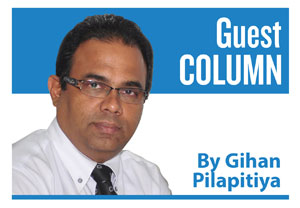Managing or mismanaging traffic?
 Managing traffic is one of the most significant challenges; congested roads are a strain on the environment, the economy and the overall quality of life. Finding smart ways to keep cities growing is crucial to our increasingly urban future.
Managing traffic is one of the most significant challenges; congested roads are a strain on the environment, the economy and the overall quality of life. Finding smart ways to keep cities growing is crucial to our increasingly urban future.
This is particularly so for those who live in and around Colombo. It has become a hindrance to overall productivity in the country and a scenario that adds to the stress of everyone confronted with it.
Many experts have conducted studies and made recommendations on traffic management but as usual no one takes positive action, other than cursing and blaming each other.
As an immediate remedy to this issue, roads such as the Baseline road, Galle road, Duplication road and High level road have to be named and managed as “clear roads” that should be free of traffic blocks all the time.
If we consider the traffic on the main lead road towards the northern parts of Colombo which is the Baseline road, the block No 1 is the timing on some of the traffic lights or the inaccuracy of timing of halting vehicular movement by the Policeman on duty.
A good example of this is the traffic congestion opposite the Welikada prison gate that allows only 30 seconds for traffic flowing from Borella junction even at peak times.
For better management of traffic flow this has to be manned manually at peak times (from 7.30 am to 10 am and 4.30 to 8.30 pm) and a permanent traffic policeman should be deployed there.
The second is the newly created turnoff to the Sri Nigrodharama road in front of the railway grounds. It is a fact that most times, traffic is blocked at this point for no reasonable reason.
It is time to build an overhead passenger bridge here so that it can ease off congestion and allow better traffic flow.
The bridge built by the Sri Lanka army engineers at the Kelaniya temple junction, or the old passenger bridges built during late president Premadasa’s time opposite Maradana railway station were good examples for such traffic control measures.
There are many instances that the road beyond the turnoff to Kolonnawa along Sri Dharmarama Mawatha is clear but due to traffic movement across the Baseline road, the traffic is stuck at Dematagoda junction and suddenly released so that the sudden volume of traffic blocks all other junctions beyond this area.
There is also a need for manual control of traffic at this point as the traffic lights in many instances are on for the wrong direction where no vehicles are in the queue.
Measures should be taken to prevent the need to cross the Baseline road here by making use of the flyover so that the vehicles that have to enter Kolonnawa road can make a u-turn under the Dematagoda flyover and enter Kolonnawa road without blocking the flow of traffic along the Baseline road.
The next is the Maligawatta junction where the Colombo – Kandy road connects with the Baseline road, creating the most traffic on any road in Sri Lanka.
There are two main traffic directions at this point; the traffic that flows from the Panchikawatta side, the traffic that flows from the Borella/Dematagoda side while the majority of the vehicle direction is towards Peliyagoda.
A probable solution is to create a side lane for traffic flow from the Panchikawatta side so that it will flow freely. For this we have to mark a separate lane on the leftmost side of Baseline road so that it will ease off traffic from this direction.
The policeman on duty here does not see the traffic build up on all roads other than on the Baseline road, (on the overhead bridge). This issue could be tackled by building a traffic control tower here.
The other solution is to demarcate a lane that can lead traffic from Dematagoda/Borella plying towards Panchikawatta through a side lane so that it can ease off traffic.
The next two locations in addition to many passenger crossings after this point are the Orugodawatta junction that connects the low level road to Baseline road and the technical junction where the New Kelani Bridge road meets the Colombo-Kandy road both which needs flyovers or underground crossings/tunnels.
It has to be noted that at least 30 per cent of the road space is taken by the containers and lorries in the areas close to the port. Action should be taken to restrict entry of these vehicles at least at selected time slots.
Sirimavo Bandaranaika Mawatha and one part of the Baseline road are always packed with containers waiting for customs weighing or customs inspection.
On Sirimavo Bandaranaika Mawatha, there is virtually only one lane available for evening traffic due to containers lining up on one lane of the road and it seems that no one cares.
It is not difficult to direct these containers and lorries to park out of these key areas and get them for these customs inspections on a batch by batch basis.
The government also has to figure out a way to make “on the road projects” more efficient as soon as possible. The good example is the time taken for laying of new pipelines in Maligawatta and Madampitiya areas which is proceeding in snail pace.
Be that as it may, it is the responsibility of the government and the Police to study vehicular traffic on all roadways closely with the help of the people living in these areas and find out what needs to be done at each junction and turnoff to improve traffic flow.
(The writer is a former chairman of the Motor Traders Association and can be reached at gihanpilapitiya @unitedmotors.lk)


